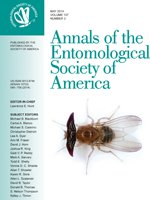The leafcutting bee Megachile (Eutricharaea) minutissima Radoszkowski is a widely distributed species in the Middle East and a promising pollinator of alfalfa. We provide information on the nest architecture, foraging behavior, phenology, and host plants of a wild population of M. minutissima studied between March 2010 and September 2012 in Amariah, a typical desert in central Saudi Arabia. Bees nested in preexisting cavities in the sandy, dry, and loose soil, and built between 2 and 14 leaf-lined brood cells per nest. Females built and provisioned 1–2 cells per day, each consisting of a large oval piece from which the cell cup was made and a small semiround piece that was used as cell cap; however, occasionally small oval pieces were also used in the latter. Cells were built from leaves of Ricinus communis L. (Euphorbiaceae), a locally abundant plant. Both sexes were captured from March to October at flowers of 11 species (10 families), indicating some degree of polylecty as well as either bivoltinism or multivoltinism. We also provide comparative taxonomie comments that will assist bee researchers to easily recognize this species.
How to translate text using browser tools
1 May 2014
Nesting Biology of the Leafcutting Bee Megachile minutissima (Hymenoptera: Megachilidae) in Central Saudi Arabia
Abdulaziz S. Alqarni,
Mohammed A. Hannan,
Victor H. Gonzalez,
Michael S. Engel
ACCESS THE FULL ARTICLE
It is not available for individual sale.
This article is only available to subscribers.
It is not available for individual sale.
It is not available for individual sale.
alfalfa
Anthophila
foraging
host plant
pollinator





